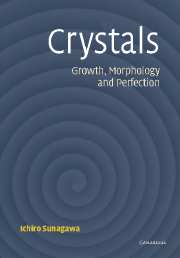Book contents
- Frontmatter
- Contents
- Foreword to the English translation
- Preface
- Part I Fundamental concepts
- Part II Application to complicated and complex systems (case studies)
- 9 Diamond
- 10 Rock-crystal (quartz)
- 11 Pyrite and calcite
- 12 Minerals formed by vapor growth
- 13 Crystals formed by metasomatism and metamorphism
- 14 Crystals formed through biological activity
- Appendixes
- Materials index
- Subject index
13 - Crystals formed by metasomatism and metamorphism
from Part II - Application to complicated and complex systems (case studies)
Published online by Cambridge University Press: 31 October 2009
- Frontmatter
- Contents
- Foreword to the English translation
- Preface
- Part I Fundamental concepts
- Part II Application to complicated and complex systems (case studies)
- 9 Diamond
- 10 Rock-crystal (quartz)
- 11 Pyrite and calcite
- 12 Minerals formed by vapor growth
- 13 Crystals formed by metasomatism and metamorphism
- 14 Crystals formed through biological activity
- Appendixes
- Materials index
- Subject index
Summary
When a hydrothermal solution permeates into a pre-existing rock, or heat and vapor components are supplied by the intrusion of magma, hydrothermal or contact metasomatism occurs, and mineral phases are newly formed. When deposited strata are placed at higher temperature and pressure conditions due to subduction owing to plate movement, metamorphism proceeds in a huge area, leading to the paragenesis of new minerals and regional metamorphic rocks. In this chapter, we shall analyze which aspects of crystal growth taking place in solid rocks are the same as or differ from those occurring in the ordinary vapor or solution phases. As representative examples, the kaolin group of minerals and trapiche emerald are selected for hydrothermal metasomatism; trapiche ruby is considered for contact metasomatism; and white mica is selected for regional metamorphism.
Kaolin group minerals formed by hydrothermal replacement (metasomatism)
Kaolin group minerals are sheet silicates, and they belong to a group of clay minerals, with 1:1 stacking of the unit layer with a chemical composition of Al2Si2O5(OH)2. Depending on the type of stacking, three polytypes, kaolinite, dickite, and nacrite, are distinguished. In addition, halloysite, containing (OH) and H2O, belongs to this group, but this will not be discussed in this chapter.
Kaolin group minerals have been used since ancient times as raw materials for china and porcelain production. They occur by the weathering of igneous rocks, such as granite, that contain a quantity of feldspar, by hydrothermal replacement (metasomatism) of pre-existing rocks, or in hydrothermal veins.
- Type
- Chapter
- Information
- CrystalsGrowth, Morphology, & Perfection, pp. 251 - 260Publisher: Cambridge University PressPrint publication year: 2005

